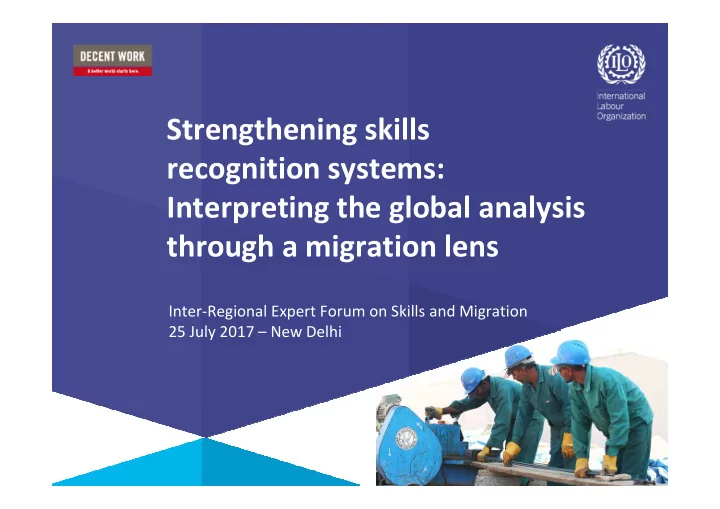

Strengthening skills recognition systems: Interpreting the global analysis through a migration lens Inter-Regional Expert Forum on Skills and Migration 25 July 2017 – New Delhi
Overview of the presentation Drawn from the conclusions and recommendations from ILO study: Understanding the potential impact of skills recognition systems on labour markets (2016)
Effective skills recognition systems require: Quality, cost- Stakeholder Needs Analysis effective and Engagement accessible services Awareness among Monitoring and users and evaluation stakeholders
1. Identifying needs • Do we understand the needs and expectations of workers, employers, governments and training providers? • Will these identified needs and expectations really be addressed by a skills recognition system?
Workers’ and employers’ priorities I want more efficiency in our I want a job hiring process I want increased productivity I want a higher I want to income increase occupational I want safety career progress
A more holistic perspective Skills Recruitment Wages
+ Competitiveness and growth + Reduce unemployment PUBLIC + Remittances PRIORITIES + Support transition from informal to formal + Ensure quality and safety standards
Clashing priorities between governments of origin and destination? High skilled Skills Spectrum ! ! Low- and semi- skilled
2. Engaging the stakeholders To boost the awareness, effectiveness and confidence in skills recognition systems requires interaction and information exchange amongst employers, workers’ groups, career services, training providers, etc. A feature of many of the most successful validation and recognition measures is strong employer involvement . - OECD Migration Outlook, 2014
Analyze the sectoral context and HRD strategies of employers In which sectors and under which circumstances are employers more likely to value formal recognition of skills? • Time required to accumulate skills and competence for adequate job performance • Health/safety requirements • Existing workplace/job regulation • Employer preference in having clearly defined standards • Pool of candidates / turnover rate
Who to engage in the sub-contracting chain??
3. Ensuring quality, cost-effectiveness and accessibility of the service provided • Financing and cost-effectiveness Is training being used as a ‘backdoor’ channel for agencies to collect fees? • Accessibility How can returning migrant workers benefit from RPL to increase employability?
Financing Models Individual Access to loans, Cost-sharing payment in installments Skills Public recognition financing Employer directly costs Cooperation of Tax deductions … Public recognition authority and PES financing indirectly
4. Raising awareness Most workers and employers do not know about skills recognition systems. The awareness rate decreases the smaller the size of the company - particularly for SMEs hiring migrant workers. WSQ (Singapore) awareness rates in 2012 by company size (%)
5. Monitoring and evaluation Monitoring and evaluation data is needed to re-orient strategies and can also be used for marketing Outputs are usually measured based on the tracking of participants, or on sample surveys of users.
Measuring Impact There is weak capacity for assessment and limited knowledge of relevant tools and methodologies. The success of a skills recognition system may only be observed years after implementation. Difficult to isolate the influence of the system from other factors. Measurement is typically based on four sources: 1. evaluation of participants after the recognition procedure; 2. employer surveys; 3. tracer studies; and 4. administrative data.
Selected indicators of impact EMPLOYERS: • Changes in productivity • Changes in number of accidents INDIVIDUALS: • Employment status prior to and after recognition • The wage / salary prior to and after recognition • Self-assessment of confidence, activation and motivation GOVERNMENTS: • Increased interest and enrolment in TVET • Decreased level of informality for occupations / sectors targeted by skills recognition
Are these elements reflected in the skills recognition systems for migrants? 1. A needs analysis 2. Stakeholder engagement 3. Quality, cost-effective and accessible services 4. Awareness among users and stakeholders 5. Monitoring and evaluation
Thank you
Recommend
More recommend